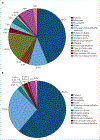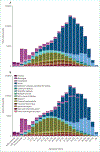The global burden of neurological disorders: translating evidence into policy
- PMID: 31813850
- PMCID: PMC9945815
- DOI: 10.1016/S1474-4422(19)30411-9
The global burden of neurological disorders: translating evidence into policy
Abstract
Neurological disorders are the leading cause of disability and the second leading cause of death worldwide. In the past 30 years, the absolute numbers of deaths and people with disabilities owing to neurological diseases have risen substantially, particularly in low-income and middle-income countries, and further increases are expected globally as a result of population growth and ageing. This rise in absolute numbers of people affected suggests that advances in prevention and management of major neurological disorders are not sufficiently effective to counter global demographic changes. Urgent measures to reduce this burden are therefore needed. Because resources for health care and research are already overstretched, priorities need to be set to guide policy makers, governments, and funding organisations to develop and implement action plans for prevention, health care, and research to tackle the growing challenge of neurological disorders.
Copyright © 2020 Elsevier Ltd. All rights reserved.
Conflict of interest statement
Declaration of interests
VLF reports that he is a CEO of the New Zealand Stroke Education (charitable) Trust, outside the submitted work. GD has served as a consultant for Boston Scientific, Cavion, and Functional Neuromodulation; has received lecture fees from Boston Scientific and royalties from Thieme publishers; and is a government employee and receives funding for his research through his institution from the German Research Council, the German Ministry of Education and Research, and Medtronic, outside the submitted work. WMC reports travel fees from Sanofi Genzyme, Biogen, and Merck, and travel and personal fees from Roche and Novartis, outside the submitted work. All other authors declare no competing interests.
Figures


Comment in
-
The growing burden of neurological disorders in low-income and middle-income countries: priorities for policy making.Lancet Neurol. 2020 Mar;19(3):200-202. doi: 10.1016/S1474-4422(19)30476-4. Epub 2019 Dec 5. Lancet Neurol. 2020. PMID: 31813849 No abstract available.
Similar articles
-
Global, regional, and national burden of neurological disorders during 1990-2015: a systematic analysis for the Global Burden of Disease Study 2015.Lancet Neurol. 2017 Nov;16(11):877-897. doi: 10.1016/S1474-4422(17)30299-5. Epub 2017 Sep 17. Lancet Neurol. 2017. PMID: 28931491 Free PMC article.
-
The burden of neurological diseases in Europe: an analysis for the Global Burden of Disease Study 2017.Lancet Public Health. 2020 Oct;5(10):e551-e567. doi: 10.1016/S2468-2667(20)30190-0. Lancet Public Health. 2020. PMID: 33007212
-
Global, regional, and national disability-adjusted life-years (DALYs) for 333 diseases and injuries and healthy life expectancy (HALE) for 195 countries and territories, 1990-2016: a systematic analysis for the Global Burden of Disease Study 2016.Lancet. 2017 Sep 16;390(10100):1260-1344. doi: 10.1016/S0140-6736(17)32130-X. Lancet. 2017. PMID: 28919118 Free PMC article.
-
Addressing the burden of mental, neurological, and substance use disorders: key messages from Disease Control Priorities, 3rd edition.Lancet. 2016 Apr 16;387(10028):1672-85. doi: 10.1016/S0140-6736(15)00390-6. Epub 2015 Oct 8. Lancet. 2016. PMID: 26454360 Review.
-
Neuroscience20 (BRAIN20, SPINE20, and MENTAL20) Health Initiative: A Global Consortium Addressing the Human and Economic Burden of Brain, Spine, and Mental Disorders Through Neurotech Innovations and Policies.J Alzheimers Dis. 2021;83(4):1563-1601. doi: 10.3233/JAD-215190. J Alzheimers Dis. 2021. PMID: 34487051 Review.
Cited by
-
Natural Biological Solutions for Chronic Pathological Problems.Biomolecules. 2024 Oct 2;14(10):1248. doi: 10.3390/biom14101248. Biomolecules. 2024. PMID: 39456181 Free PMC article.
-
The nonlinear relationship between triglyceride glucose-waist circumference and stroke risk in middle-aged and elderly people: a nationwide prospective cohort study of the CHARLS.Lipids Health Dis. 2024 Aug 22;23(1):264. doi: 10.1186/s12944-024-02259-x. Lipids Health Dis. 2024. PMID: 39174982 Free PMC article.
-
Report on the Joint Workshop on the Relations between Health Inequalities, Ageing and Multimorbidity, Iceland, May 3-4, 2023.Clin Epidemiol. 2024 Jan 16;16:9-22. doi: 10.2147/CLEP.S443152. eCollection 2024. Clin Epidemiol. 2024. PMID: 38259327 Free PMC article.
-
Drug Development for Alzheimer's and Parkinson's Disease: Where Do We Go Now?Pharmaceutics. 2024 May 24;16(6):708. doi: 10.3390/pharmaceutics16060708. Pharmaceutics. 2024. PMID: 38931832 Free PMC article. Review.
-
Correlation Between Oncostatin M and Acute Ischemic Stroke: A Case-Control Study.Cureus. 2023 Dec 10;15(12):e50297. doi: 10.7759/cureus.50297. eCollection 2023 Dec. Cureus. 2023. PMID: 38205475 Free PMC article.
References
-
- Feigin VL, Vos T. Global burden of neurological disorders: from Global burden of disease estimates to actions. Neuroepidemiology 2019; 52: 1–2. - PubMed
Publication types
MeSH terms
Grants and funding
LinkOut - more resources
Full Text Sources
Medical
Miscellaneous

